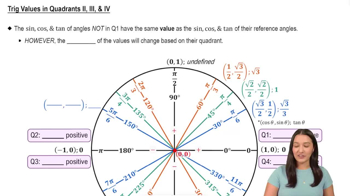Table of contents
- 0. Review of College Algebra4h 43m
- 1. Measuring Angles39m
- 2. Trigonometric Functions on Right Triangles2h 5m
- 3. Unit Circle1h 19m
- 4. Graphing Trigonometric Functions1h 19m
- 5. Inverse Trigonometric Functions and Basic Trigonometric Equations1h 41m
- 6. Trigonometric Identities and More Equations2h 34m
- 7. Non-Right Triangles1h 38m
- 8. Vectors2h 25m
- 9. Polar Equations2h 5m
- 10. Parametric Equations1h 6m
- 11. Graphing Complex Numbers1h 7m
3. Unit Circle
Reference Angles
Problem 85a
Textbook Question
In Exercises 61–86, use reference angles to find the exact value of each expression. Do not use a calculator. sin (-17𝜋/3)
 Verified step by step guidance
Verified step by step guidance1
<Step 1: Determine the standard position angle.> Start by finding the equivalent angle between 0 and 2π by adding 2π until the angle is positive. Since -\(17\pi/3\) is negative, add \(2\pi\) (or \(6\pi/3\)) repeatedly until the angle is positive.
<Step 2: Simplify the angle.> Calculate \(-17\pi/3 + 6\pi/3 = -11\pi/3\). Continue adding \(6\pi/3\) until the angle is between 0 and \(2\pi\).
<Step 3: Find the reference angle.> Once you have the positive angle, determine the reference angle. The reference angle is the acute angle that the terminal side of the angle makes with the x-axis.
<Step 4: Determine the sine of the reference angle.> Use the reference angle to find the sine value. Remember that the sine function is positive in the first and second quadrants and negative in the third and fourth quadrants.
<Step 5: Apply the sign based on the quadrant.> Determine the sign of the sine function based on the quadrant in which the original angle's terminal side lies.>
Recommended similar problem, with video answer:
 Verified Solution
Verified SolutionThis video solution was recommended by our tutors as helpful for the problem above
Video duration:
4mPlay a video:
Was this helpful?
Key Concepts
Here are the essential concepts you must grasp in order to answer the question correctly.
Reference Angles
A reference angle is the acute angle formed by the terminal side of an angle in standard position and the x-axis. It is always positive and helps in determining the sine, cosine, and tangent values of angles beyond the first quadrant. For angles greater than 360 degrees or less than 0 degrees, the reference angle can be found by reducing the angle to its equivalent within the range of 0 to 2π.
Recommended video:

Reference Angles on the Unit Circle
Unit Circle
The unit circle is a circle with a radius of one centered at the origin of a coordinate plane. It is fundamental in trigonometry as it provides a geometric representation of the sine, cosine, and tangent functions. The coordinates of points on the unit circle correspond to the cosine and sine values of angles, allowing for easy calculation of trigonometric functions for any angle.
Recommended video:

Introduction to the Unit Circle
Sine Function
The sine function, denoted as sin(θ), is a fundamental trigonometric function that relates the angle θ to the ratio of the length of the opposite side to the hypotenuse in a right triangle. On the unit circle, it represents the y-coordinate of a point corresponding to the angle θ. Understanding the sine function is crucial for evaluating trigonometric expressions, especially when using reference angles.
Recommended video:

Graph of Sine and Cosine Function

 5:31m
5:31mWatch next
Master Reference Angles on the Unit Circle with a bite sized video explanation from Callie Rethman
Start learningRelated Videos
Related Practice






















